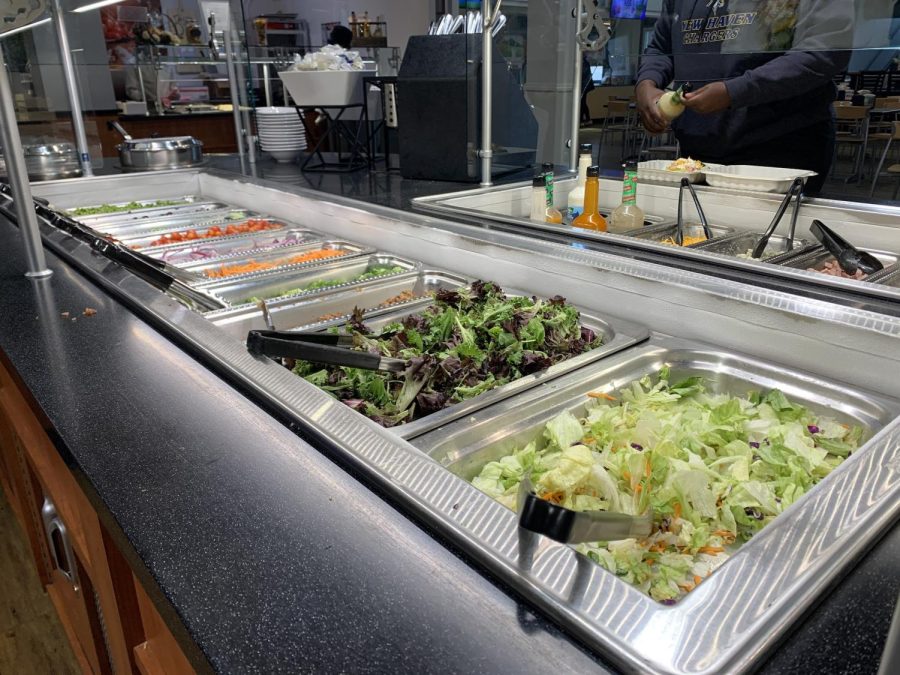The supply chain disruption’s effect on university students
Photo courtesy of Kayla Mutchler
The salad bar at The Marketplace in Bartels Hall, West Haven.
A recent notice in the University of New Haven dining halls saying that pans were now being sprayed by soybean oil was the only noticeable impact on campus of our current supply chain disruption. However, the world is in the midst of a global supply chain crisis as a consequence of the COVID-19 pandemic that could give consumers a stressful holiday season.
From a severe lack of computer chip manufacturing, to congested trade routes and under-supplied food items, countries across the world are having to adapt to slower arrival times for goods.
The global supply chain serves as the symbolic pathway that every good travels along, from the start of the manufacturing stage to the customer who paid for the product. It consists of a collection of people, companies, warehouses, transportation companies and retailers that coordinate to produce and release products.
According to University of New Haven assistant professor of economics Patrick Gourley,
this supply chain has been put under stress as economies are bouncing back and adapting to a post-COVID-19 labor force.
“During COVID, much of the economy shut down, either completely or partially,” said Gourley. “Given the complexity and ‘just-in-time’ strategy many industries use, getting back to normal is going to cause hiccups.”
A “just-in-time” (JIT) system is a strategy that aims to limit inventory and improve efficiency, decreasing waste and delivering products to consumers quickly. The issue is that this strategy heavily relies on steady production, no machine breakdowns, workmanship and suppliers: something that the pandemic has made more uncertain.
“Most industries use a just-in-time supply chain,” Gourley said. “This keeps goods cheaper and businesses don’t have to pay for storage.”
Labor shortages also hurt production capabilities as workers argue for more rights amid the pandemic. Thousands of workers in the U.S. are calling for better wages, working conditions and benefits, with many having worked in unsafe environments during the pandemic. Many strikes are challenging the workplace’s status quo.
Cargo ships looking to make deliveries or pick-ups at ports around the world have been left waiting in long lines. In early October, nearly 500,000 shipping containers were stranded outside of Southern California ports as they faced a backlog of traffic. High demand has also made it difficult for supply to keep up.
In the context of a JIT system, Gourley said this causes supply chain issues to add-up and expand to industries throughout the economy.
At the university, effects of the supply chain breakdown have been most directly felt through the change in oil used for cooking. The notice, posted at several stations in The Marketplace at Bartels Hall, said that a different kind of oil was used for the pan spray due to the global supply chain crisis. Cooks used “Sysco” pan spray that contained soybean oil after it was mistakenly delivered in one of their shipments last month.
Samantha Zajac, the registered dietitian for the university, said the change was just temporary and students could expect it to go back to normal soon.
“To date [Nov. 1] I have one can left of the Sysco pan spray,” Zajac said. “I anticipate taking down the disclaimers in the next week.”
For students with a soy allergy, dining services was diligent to notify and mark the soybean oil for protection according to Zajec. Though this was easily addressed, it shows that a change in the global supply chain can force the university to quickly adapt their operations.
Students may anticipate more inconveniences this holiday season. Delays, limited supplies and higher prices are all expected for consumers in the coming months, meaning it may be more difficult for shoppers to get what they want. For example, Nike could lose over 100 million pairs of shoes following factory closures in Vietnam.
Some markets will be more affected than others according to Gourley, who foresees these problems lasting at least three more months.
“A small minority of goods may be unavailable––I’ve heard stories of people waiting 6+ months for furniture,” Gourley said. “For most goods though, it means waiting a bit longer than usual or paying a bit more.”
Gourley said that despite the effects we’re seeing now, there is no reason to panic too much; consumers can still get most of what they want, just at higher costs and wait times. It shouldn’t reach “crisis” level until a significant amount of goods are totally unavailable, he said.
“I think a sense of perspective is warranted,” he said. “There are certainly supply chain issues right now, but I disagree with calling it a disaster, crises, etc.”






